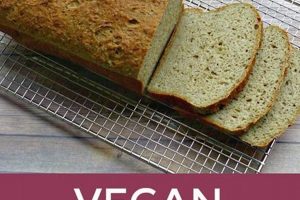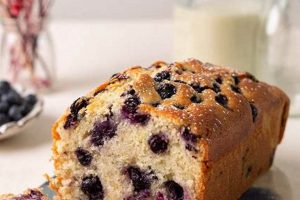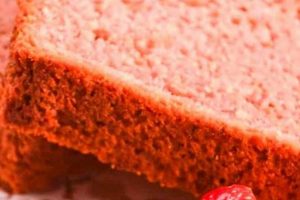A fundamental formula for creating a flour-based loaf without animal products represents a core skill in plant-based cuisine. It typically involves combining flour, water, yeast, and salt, occasionally with the addition of sweeteners or oils, to form a dough that rises and bakes into a palatable staple. This formulation omits ingredients such as eggs, dairy milk, or butter, commonly found in conventional baking.
The ability to produce this kind of loaf offers multiple advantages. It provides dietary control, allowing individuals to avoid animal-derived ingredients for ethical, health, or allergy-related reasons. It can also be a more economical option, particularly when using readily available ingredients. Moreover, such methods align with sustainable practices by reducing reliance on animal agriculture. Historically, similar bread-making techniques existed across various cultures, often relying on locally sourced grains and natural leavening agents.
Understanding the principles of this culinary creation opens pathways to further exploration of vegan baking techniques. Subsequent discussions can delve into topics such as flour selection, yeast activation, proofing processes, and oven temperature management to achieve optimal results. Furthermore, variations in ingredients and techniques can yield diverse flavor profiles and textures, enhancing the versatility of the finished product.
Essential Guidance
The following information offers strategies for successful implementation of a fundamental plant-based loaf creation. Adherence to these points can significantly impact the final product’s quality and texture.
Tip 1: Yeast Activation. Ensure the yeast is viable before combining it with the remaining ingredients. Proofing involves mixing the yeast with warm water and a small amount of sugar. If the mixture does not foam within 5-10 minutes, the yeast may be inactive.
Tip 2: Flour Selection. Different types of flour will yield varying textures. Bread flour, with a higher protein content, is often preferred for its gluten-forming capabilities, resulting in a chewier structure. All-purpose flour can be used but may produce a less robust crumb.
Tip 3: Water Temperature. Water temperature plays a crucial role in dough development. Water that is too hot can kill the yeast, while water that is too cold can slow its activity. A temperature range of 105-115F (40-46C) is generally recommended.
Tip 4: Kneading Technique. Thorough kneading is essential for developing gluten, which provides structure and elasticity. Insufficient kneading can result in a dense, under-risen loaf. A minimum kneading time of 8-10 minutes is typically advised, either by hand or using a stand mixer.
Tip 5: Proofing Environment. The dough requires a warm, draft-free environment for optimal rising. A slightly warm oven (turned off) or a proofing box can provide ideal conditions. Covering the dough with a damp cloth prevents the surface from drying out.
Tip 6: Oven Temperature Control. Precise oven temperature is critical for proper baking. Ovens can vary in accuracy, so using an oven thermometer is recommended. A temperature of 375-400F (190-200C) is a standard starting point, but adjustments may be necessary based on the specific formulation and oven.
Tip 7: Cooling Process: Allow the baked loaf to cool completely on a wire rack before slicing. This prevents a gummy texture and allows the internal structure to set properly.
Consistent application of these techniques contributes to the creation of an acceptable plant-based baked product. Careful monitoring of each stage is imperative for success.
The following sections will address ingredient substitutions and recipe variations for advanced development.
1. Ingredient substitution
Ingredient substitution is fundamentally linked to the formulation of plant-based bread. Conventional bread recipes often include animal-derived components like eggs, dairy milk, and butter, each serving distinct structural and flavor functions. To create a comparable product without these, alternative ingredients must be identified that mimic or replace those functions. The effectiveness of these substitutes directly influences the bread’s texture, crumb, moisture content, and overall palatability. For instance, flaxseed meal mixed with water can act as a binding agent similar to eggs, while plant-based milks provide the necessary liquid and contribute to a softer crumb. Failure to accurately replicate the properties of original components will negatively impact the outcome.
The process of ingredient substitution within plant-based bread extends beyond simple replacement. Each substitution has a ripple effect, potentially altering other aspects of the process. For instance, the inclusion of a higher-moisture substitute might necessitate adjustments in flour quantity or baking time. Similarly, alternatives lacking the emulsifying properties of eggs may require the addition of an emulsifier like lecithin to prevent separation of ingredients. Examples include using applesauce to add moisture and sweetness, or aquafaba (the liquid from canned chickpeas) as a binding agent with foaming capabilities similar to egg whites. The selection and implementation of appropriate substitutions is a crucial determinant of success in this area of baking.
In essence, successful creation of plant-based baked bread hinges on a thorough understanding of ingredient functionality and the subsequent implementation of effective substitutions. While various combinations exist, careful consideration of ingredient properties and their interactions is paramount. Achieving an acceptable result often requires experimentation and iterative adjustments to compensate for variations in ingredient characteristics. This adaptability, combined with a solid grasp of the fundamentals, permits both replication of traditional bread styles and the development of innovative plant-based alternatives, while also addressing dietary requirements and ethical concerns.
2. Yeast Activation
Yeast activation represents a foundational step in creating a standard flour-based loaf without animal products. The biological process of fermentation, facilitated by yeast, is responsible for the leavening, flavor development, and textural attributes of the final product. A basic plant-based formula relies on this process in the absence of other common leavening agents like eggs or dairy, which contribute to structure and rise in conventional baking. Inadequate or failed activation directly translates to a dense, unpalatable bread with minimal volume and a compromised flavor profile. For example, yeast exposed to excessively hot water will be rendered inactive, preventing the necessary rise.
The activation process typically involves providing the yeast with a warm, moist environment and a small amount of sugar for initial nourishment. This mixture, when viable, will exhibit visible signs of activity, such as foaming or bubbling, indicating that the yeast is metabolizing the sugar and producing carbon dioxide, the gas responsible for leavening. The absence of these signs suggests either inactive yeast or unfavorable environmental conditions, necessitating a reassessment of the activation procedure. For instance, using water that is too cold will significantly slow down yeast activity, while using old or improperly stored yeast might result in minimal or no activity at all.
In summary, successful creation of a standard plant-based loaf is contingent on proper yeast activation. The process provides the necessary biological leavening for acceptable bread texture and volume. Challenges can arise from improper temperature control, unsuitable activation environments, or the use of non-viable yeast. Consistent monitoring of the activation process is crucial and directly influences the ultimate quality of the baked product, highlighting the critical nature of this stage in plant-based bread making.
3. Gluten development
Gluten development is a fundamental process in achieving desired texture and structure in a standard plant-based loaf creation. The formation of a network of gluten proteins, derived from wheat flour, is essential for trapping gases produced during fermentation, thereby enabling the bread to rise and maintain its shape.
- The Role of Kneading
Kneading is the primary method for fostering gluten development. The mechanical action of kneading aligns and strengthens the gluten strands, creating a cohesive and elastic dough. Insufficient kneading results in a weak gluten network, leading to a dense and crumbly baked product. Conversely, over-kneading can damage the gluten structure, causing a tough and inelastic texture. For instance, a standard plant-based recipe typically requires 8-10 minutes of kneading to achieve optimal gluten formation.
- Impact of Flour Type
The type of flour used directly influences gluten development. Bread flour, with its higher protein content (primarily glutenin and gliadin), forms a stronger gluten network compared to all-purpose flour. This is because bread flour provides a greater quantity of the proteins necessary for gluten formation. In recipes where a robust structure is desired, the selection of high-protein flour is essential. For example, using cake flour, which has a low protein content, will result in minimal gluten development, rendering it unsuitable for bread making.
- Hydration Levels
Water is a critical component in gluten development, as it hydrates the glutenin and gliadin proteins, allowing them to bond and form the gluten network. Insufficient hydration inhibits gluten formation, resulting in a dry and stiff dough. Excessive hydration weakens the gluten structure, leading to a sticky and unmanageable dough. The appropriate water-to-flour ratio is crucial for achieving optimal gluten development. Different types of flours absorb water at varying rates, requiring adjustments in hydration levels. As an example, whole wheat flour typically requires more water than refined white flour.
- Resting Time (Autolyse)
Allowing the flour and water to rest for a period before kneading (autolyse) can enhance gluten development. This process allows the flour to fully hydrate, facilitating the formation of gluten bonds more readily during subsequent kneading. The autolyse technique can reduce kneading time and improve the elasticity and extensibility of the dough. A rest period of 20-30 minutes is generally sufficient to promote the benefits of autolyse.
The effective management of gluten development, through appropriate kneading, flour selection, hydration control, and optional resting periods, is essential for achieving a palatable loaf without animal products. Understanding these factors allows for consistent results and provides a basis for adapting formulations to specific ingredient availability and desired textural characteristics.
4. Proofing conditions
The proofing environment constitutes a critical determinant in the successful production of a fundamental flour-based loaf without animal products. This phase, wherein the dough rests following kneading, allows yeast to generate carbon dioxide, leading to dough expansion and the development of a characteristic open crumb structure. Suboptimal proofing conditions, specifically temperature and humidity, directly impede yeast activity, resulting in a dense, under-risen product. For instance, a dough exposed to temperatures below 70F (21C) will exhibit significantly slower fermentation rates compared to a dough maintained at the optimal range of 75-85F (24-29C). Inadequate humidity also leads to surface drying, inhibiting expansion and potentially forming a crust that restricts further rising.
The effects of proofing parameters extend beyond mere volume expansion; flavor development is also intrinsically linked to this stage. Extended proofing times, within acceptable temperature ranges, allow for the generation of complex aromatic compounds through enzymatic activity and yeast metabolism, enriching the overall flavor profile of the final loaf. However, excessive proofing can lead to over-fermentation, resulting in a sour or acidic taste and a weakened gluten structure. Controlling the proofing environment is, therefore, essential for achieving not only the desired volume but also a balanced and palatable flavor. One practical method involves placing the dough in a slightly warmed (but switched off) oven with a pan of hot water to maintain consistent temperature and humidity.
In conclusion, meticulous control of proofing conditions is paramount for consistent creation of an acceptable plant-based loaf. Temperature, humidity, and proofing time interact to directly influence volume, texture, and flavor characteristics. Failure to appropriately manage these factors often leads to unacceptable results, highlighting the importance of understanding and controlling the proofing environment. Subsequent steps in breadmaking, such as baking, are built upon the foundation established during proofing; thus, optimizing this stage directly impacts the quality and success of the entire process.
5. Oven temperature
Oven temperature exerts a profound influence on the final characteristics of a flour-based vegan loaf. The application of heat initiates several critical processes, including starch gelatinization, protein coagulation, and moisture evaporation, each contributing to the bread’s structure, texture, and crust formation. Insufficient temperature will result in a pale, undercooked loaf with a gummy interior. Conversely, excessive temperature can lead to a burnt crust and a dry, dense crumb. As an example, a loaf baked at 325F (163C) may exhibit poor rise and an unpalatable texture, while the same formulation baked at 450F (232C) could develop an overly dark and brittle crust.
The selection of an appropriate baking temperature is further complicated by variations in oven calibration and loaf size. A standard recipe might specify 375F (190C) as the optimal temperature, but individual ovens can deviate significantly from this setting. Using an oven thermometer to verify the actual temperature is essential for consistent results. Larger loaves require longer baking times at lower temperatures to ensure thorough cooking without excessive browning. Plant-based formulations, lacking the buffering effects of animal fats and proteins, are particularly susceptible to temperature fluctuations, making accurate control paramount. The specific temperature also interacts with other recipe components; higher sugar content, for instance, necessitates a lower baking temperature to prevent premature browning.
In summary, oven temperature is a critical, controllable variable in the production of a standard vegan loaf. Understanding its effects on the bread’s physical and sensory properties allows for informed adjustments to achieve consistent and desirable outcomes. While specific temperature recommendations serve as a starting point, careful monitoring and adaptation based on individual oven characteristics and recipe variations are necessary. Achieving mastery of oven temperature control contributes significantly to the ability to reliably produce palatable plant-based baked goods.
6. Cooling process
The cooling process, often overlooked, represents a crucial final stage in creating a standard flour-based loaf that lacks animal products. Allowing the loaf to cool properly significantly influences the final texture, moisture content, and overall palatability. Premature slicing can result in a gummy texture and accelerated staling, compromising the quality of the finished product.
- Starch Retrogradation
Starch retrogradation is the process by which starch molecules realign themselves as the bread cools. This realignment causes the starch to recrystallize, firming the bread’s structure and solidifying the crumb. Slicing the loaf while it is still hot disrupts this process, leading to a gummy texture and increased susceptibility to staling. The cooling process allows for proper starch retrogradation, resulting in a more stable and palatable crumb structure.
- Moisture Redistribution
During baking, moisture migrates within the loaf. The cooling process allows this moisture to redistribute evenly throughout the crumb. Slicing a hot loaf releases this trapped moisture, leading to a dry and potentially sticky texture. Allowing the loaf to cool completely permits the internal moisture to equalize, resulting in a more consistent and desirable level of hydration.
- Crust Stabilization
The crust undergoes structural changes during cooling as well. Initially, the crust is often crisp and brittle. As the bread cools, moisture migrates from the crumb to the crust, slightly softening it and creating a more balanced texture. Cutting the loaf while the crust is still hot can cause it to become soggy or detach from the crumb. Proper cooling stabilizes the crust, enhancing its texture and structural integrity.
- Flavor Development
Subtle flavor changes continue to occur as the bread cools. Volatile aromatic compounds, formed during baking, evolve and mature during this period. Slicing a hot loaf can dissipate these aromas prematurely, diminishing the overall flavor complexity. Allowing the loaf to cool allows these flavors to fully develop, enhancing the sensory experience.
Considering these facets of the cooling process in creating a plant-based baked bread allows for maximized quality. Adherence to proper cooling techniques contributes significantly to the overall enjoyment of the final product, emphasizing the importance of this often-neglected step in the bread-making process. Failure to allow for proper cooling can negate effort invested in prior steps.
7. Texture Variation
Texture variation in a basic flour-based loaf that lacks animal products is a crucial factor determining palatability and overall acceptability. Achieving diverse textures relies on manipulating ingredients and techniques during the baking process. Different textures cater to varied culinary applications and individual preferences.
- Crumb Structure
Crumb structure, referring to the internal cellular arrangement of the bread, can range from open and airy to dense and compact. An open crumb is characterized by large, irregular holes, typically achieved through high hydration doughs and extended fermentation. Conversely, a dense crumb features small, uniform air pockets, often resulting from lower hydration and shorter fermentation periods. For example, a plant-based baguette typically exhibits an open crumb, ideal for soaking up sauces, while a dense plant-based rye bread suits sandwiches with moist fillings.
- Crust Characteristics
The crust’s texture can vary from crisp and thin to thick and chewy. High baking temperatures and the application of steam during the initial baking phase promote a crisp, thin crust. Lower temperatures and the absence of steam result in a softer, thicker crust. A thin, crisp crust is desirable for certain artisan breads, while a thicker, chewier crust complements heartier loaf styles. For example, a plant-based sourdough bread often showcases a thick, chewy crust, providing a textural contrast to the softer crumb.
- Moisture Content
The perceived moistness or dryness of the bread significantly influences its textural properties. Higher water content in the dough and shorter baking times contribute to a moister texture. Conversely, lower water content and longer baking times lead to a drier texture. A moist loaf is suitable for consumption on its own or with simple toppings, while a drier loaf may be preferred for toasting or creating croutons. As an example, a basic plant-based sandwich bread is typically formulated to be relatively moist, ensuring a soft and palatable texture.
- Ingredient Modifications
Specific ingredients can be added or modified to alter bread texture. The inclusion of whole grains, such as whole wheat or rye flour, adds a coarser texture and increased density. The addition of fats or oils contributes to a softer crumb and enhanced moisture retention. For instance, incorporating flaxseed meal into a plant-based bread formula increases moisture and produces a slightly chewier texture. In contrast, using a greater proportion of bread flour leads to a more structured and elastic texture. This is due to the high protein content that increases structure.
These elements directly relate to the versatility of a basic flour-based vegan bread recipe and its adaptability to various culinary needs and preferences. By manipulating these factors, bakers can tailor the texture to suit specific applications, thereby broadening the appeal and utility of plant-based baking.
Frequently Asked Questions
This section addresses common inquiries regarding the preparation and characteristics of a fundamental flour-based loaf produced without animal products. It aims to clarify potential challenges and provide concise, informative responses.
Question 1: What constitutes a “basic” plant-based bread formulation?
A basic recipe generally comprises flour, water, yeast, and salt. Optional ingredients may include sweeteners or oils to enhance flavor or texture. The defining characteristic is the absence of animal-derived ingredients such as eggs, dairy milk, or butter.
Question 2: Can different types of flour be used interchangeably?
Different flour types impact texture. Bread flour, with higher protein content, is recommended for optimal gluten development. All-purpose flour can be substituted, but may result in a less robust structure. Other flours, such as whole wheat or rye, introduce unique flavor profiles and textures, requiring adjustments to hydration and kneading.
Question 3: What are common substitutes for eggs in plant-based bread making?
Common egg substitutes include flaxseed meal mixed with water, applesauce, or aquafaba (the liquid from canned chickpeas). These ingredients provide binding, moisture, or emulsifying properties typically associated with eggs. The appropriate substitute depends on the specific recipe and desired outcome.
Question 4: How can successful yeast activation be ensured?
Yeast viability should be confirmed by mixing it with warm water and a small amount of sugar. The mixture should foam within 5-10 minutes, indicating active fermentation. Inactive yeast will prevent proper rising and result in a dense loaf. Discard and replace inactive yeast.
Question 5: What is the ideal temperature range for proofing the dough?
A temperature range of 75-85F (24-29C) is generally recommended for optimal yeast activity during proofing. Maintain consistent temperature and humidity to promote uniform rising and prevent surface drying. Avoid temperatures exceeding 90F (32C), as this can negatively impact yeast activity.
Question 6: Why is it important to allow the loaf to cool completely before slicing?
Cooling permits starch retrogradation and moisture redistribution, stabilizing the crumb structure and preventing a gummy texture. Premature slicing disrupts these processes, leading to accelerated staling and a less palatable product. Complete cooling also allows the flavors to fully develop.
In conclusion, mastering the fundamentals of this procedure enables consistent creation of baked breads without animal ingredients. Attention to detail throughout each stage significantly impacts the final outcome.
The subsequent section explores advanced techniques and variations for plant-based bread baking.
Conclusion
The preceding discussion has detailed the essential components and processes involved in creating a “basic vegan bread recipe”. From ingredient substitution to controlled cooling, each step significantly influences the final product’s texture, flavor, and overall quality. Mastery of these techniques provides a foundation for consistent production of palatable flour-based loaves without animal products.
Further exploration of vegan baking techniques beyond the elementary stages will necessitate a continued focus on ingredient interaction, process optimization, and a commitment to precision. Consistent application of the principles outlined herein will allow both novice and experienced bakers to expand their skillsets and contribute to the growing landscape of plant-based cuisine. The knowledge provided promotes a dietary option and contributes to increased understanding of baking fundamentals.







